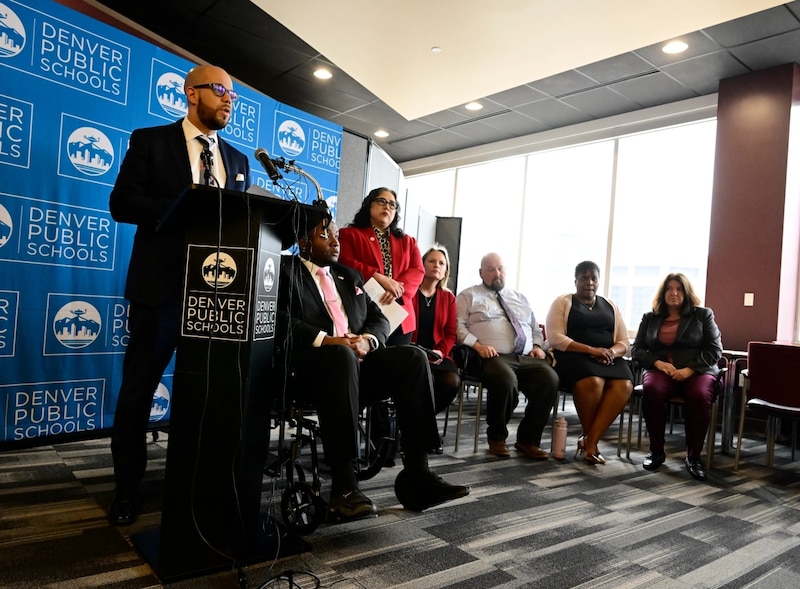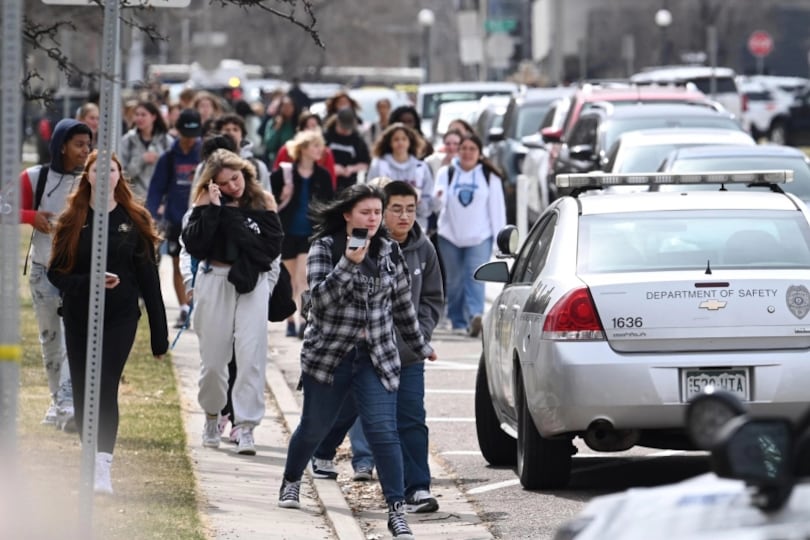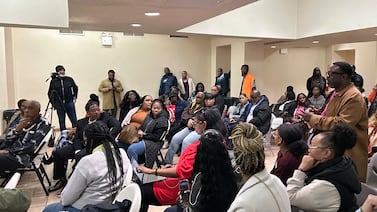Over the past decade, Denver Public Schools’ approach to discipline has swung decidedly toward keeping students in school rather than kicking them out.
Safety begins with positive relationships between staff and students and a positive school climate, the district’s discipline policy says. Bringing a gun to school is the only offense that automatically results in an expulsion hearing for a student. Even students facing serious criminal charges can stay in school as long as they are not behind bars.
Last month’s shooting of two East High School deans by a student who was being searched for weapons has placed renewed scrutiny on discipline in Colorado’s largest school district.
But so far, Denver Public Schools has held firm to its approach.
“We are a welcoming environment,” DPS Deputy Chief of Staff Deborah Staten said in an interview this week. “We really want students to be in their school environment.”
The debate now playing out in Denver — with some saying the pendulum has swung too far toward tolerance and others fearful of a return to policies that harm marginalized students — illustrates the difficulty of striking the right balance on discipline amidst rising gun violence.
“There’s just no discipline, there’s no accountability, there’s no structure,” said Heather Weldon, whose daughter is an eighth grader at McAuliffe International School, where the principal spoke out about DPS denying his request to expel a student charged with attempted murder.
“Right now, there’s no consequences, it feels like,” Weldon said.
She and other parents say there has to be a better way — some middle ground between anything-goes and zero-tolerance. The Denver principals union has called for changes too, including revisions to the district’s discipline guide and a new process for deciding on appropriate school placements for students who might harm others.
But advocates who have worked for years to keep young people out of the criminal justice system worry that the shooting at East — a high-profile school where the city’s power brokers send their children — will tip the scales back toward punitive punishment that disproportionately affects Black and Latino students.
A day after the shooting, the school board lifted its policy banning armed police on campus.
“It terrifies me,” said Elie Zwiebel, a Denver attorney who represents kids in school expulsion hearings and juvenile court — kids who he said in past decades might have been unfairly painted as violent and hardened criminals. “The ultimate problem is that everyone is buying into the myth again and forgetting that we’re talking about children.”
Denver approach to discipline keeps kids in school
On March 22, East High student Austin Lyle shot two deans who were searching him as part of a safety plan that was in place due to his past behavior. The deans survived. Lyle, who was 17, later died by suicide. He was on probation for a weapons charge, according to media reports, and had been expelled from the suburban Cherry Creek School District.
But expulsions aren’t forever. By the time Lyle transferred to East mid-year, his Cherry Creek expulsion had expired. He was living in the East boundary and that’s why he enrolled there, Staten said.
That a student with a weapons charge, who was being searched daily by school staff for guns, was able to enroll in and remain at a traditional public high school has put heightened focus on DPS’s discipline matrix. The matrix is a guide for school staff about when they should or should not call the police and when they can suspend or expel a student.
The matrix was last amended in the fall of 2021. At that time, DPS added bright red letters at the top. “You make a difference in breaking historical patterns of inequity,” it says. “Disrupt bias, fight disproportionality, and apply the discipline matrix in an anti-racist and trauma-informed manner.”
Under the matrix, the only offense that automatically results in an expulsion hearing is bringing a gun to school. Everything else, including sexual assault and selling drugs, is up to district administrators.
The number of expulsions in Denver has fallen over the past decade. In the 2011-12 school year, Denver expelled 63 students, according to state data. In 2021-22, it expelled just 21.
Compare that to Cherry Creek, a smaller district that suspended 142 students last school year.
The language and tone in the two districts’ policies could not read more differently.
Denver: “School safety and academic success are formed and strengthened when all school staff and personnel build positive relationships with students and are actively engaged in their lives and learning. … Effective discipline is built on consistent and effective classroom management, and is supported by a positive school climate.”
Cherry Creek: “The administration has the right to expect full cooperation of employees in the planning and execution of discipline and control procedures including support for removing students who persistently or flagrantly misbehave.”
Cherry Creek officials declined an interview request for this story.
Denver and Cherry Creek differ on expulsion
The districts’ differing philosophies were clear at a legislative hearing at the state Capitol on March 2, just three weeks before the East shooting. Both districts testified on a bill that would have given students more rights in expulsion hearings and made it harder to expel students for nonviolent offenses or for behavior that occurred off school property.
Denver was the only district to testify in favor. Denver Public Schools attorney Elise Logemann said during testimony that the district already does much of what the bill would have mandated, including requiring there be a “direct and substantial nexus between the student’s alleged conduct committed off school grounds and the risk of physical harm to other students or school personnel.”
Denver students and current and former staff members testified in favor too.
“Many people thought I was a bad kid and that I was a bully, but my anger was actually sadness,” said Lorenzo Gomez, a 16-year-old student at AUL Denver who told lawmakers he frequently got into fights before going to AUL, a small charter school for students who’ve struggled elsewhere.
“All kids deserve a second chance and a supportive place to go to school,” he said.
Cherry Creek joined the Harrison and Fountain-Fort Carson districts in Colorado Springs, along with the Colorado Association of School Executives, the Colorado Association of School Boards, and the Colorado Rural Schools Alliance, in opposing the bill.
Cherry Creek doesn’t require a connection to school to expel a student for off-campus behavior. Sonja McKenzie, an attorney for the district, said requiring one would prevent Cherry Creek from expelling potentially dangerous students.
She gave an example she said happened this year: A Cherry Creek student shot another teenager in a park. The victim attended a neighboring school district. Under the bill, she said, there would have been no grounds to expel the shooter because the victim didn’t go to Cherry Creek.
“But you tell me, would you want your child attending that school with that child who had a gun — and maybe had that gun on school grounds and we just didn’t know it?” McKenzie said.
More people testified in support of the bill than against it. But after the East shooting, state lawmakers killed the bill and introduced a scaled-back version instead.

Educators struggle to balance safety, learning
Attorney Lindsay Brown said she’s seen Denver’s approach to discipline change over time. Ten years ago, she said DPS was more punitive. She remembers representing a student athlete with a supportive family who was expelled for bringing brass knuckles to school.
While Brown said that would still happen in many suburban districts, she has for years now felt like Denver is more likely to give students a fair hearing.
“Denver has historically been a place where you can go in and speak to the hearts and minds of teachers and administrators,” Brown said. “I’ve always felt like they were really trying to do the right thing.”
She worries that the recent violence will change that.
“I am concerned that schools are going to start to wash their hands of quote-unquote problem kids using this umbrella of, ‘Well, these things happen, so we can’t be too safe,’” she said.
Elsa Bañuelos-Lindsay has the same fears. She’s executive director of Movimiento Poder, a Denver community organization formerly known as Padres & Jóvenes Unidos that for years led the fight to reduce suspensions and expulsions in DPS and statewide. She said putting police officers back into Denver schools is a sign that DPS is going in the wrong direction.
“It’s going to harm more of our students, especially students of color,” Bañuelos-Lindsay said.
Rob Gould, president of the Denver Classroom Teachers Association, is somewhere in the middle. Asked if the pendulum had swung too far toward keeping students in school, he said yes and no. If given the choice of smaller class sizes or more metal detectors because of limited funding, educators would choose the former, he said.
“We’re still trying to figure this out,” Gould said.
But attorney Igor Raykin, who also represents students in expulsion proceedings, said he thinks that after the racial justice protests of 2020, Denver and other urban districts “overcorrected and began to be tolerant of behaviors they shouldn’t be tolerant of.”
While he believes expulsion is disruptive to a student’s life and should be used sparingly, he said that needs to be balanced with keeping other students and teachers safe. Expelling a student just means they can’t go back to their current school. It doesn’t mean they can’t access an education, Raykin said, even if that’s through remote learning online.
Former DPS principal Kimberly Grayson said she moved students to remote or hybrid learning — over the objections of the district — if she felt their presence put other students at risk.
Last school year, after one of her students at Dr. Martin Luther King, Jr. Early College was killed by gunfire on a weekend and police arrested another student on suspicion of the crime, Grayson said she and her staff figured out which of their classmates were involved in the rivalry.
Each was handed a computer and a message: “You’re going to finish this year out at home on your Chromebook. It’s dangerous for you to be here. For you and for everybody else here,” Grayson recently told activist and podcast host brother jeff Fard.
“The district told me I couldn’t do it,” Grayson said. “Oh yes, I am. We’re going to support them with their education. We’re going to give them a Chromebook.”
Grayson said she thinks DPS’s approach to discipline shifted too far over the years.
“They went from zero tolerance to complete tolerance,” she said in an interview. “I realize you want numbers [of suspensions and expulsions] to decrease for Black and brown kids. However, there still needs to be some consequences for some actions.”
Staten, the deputy chief of staff for DPS, said the district’s position is that a student can be in their regular public school — even if they’re facing criminal charges — as long as a judge has decided that the student can be out in the community and not behind bars.
“There are times where we may need to talk to probation to see what the terms and conditions are,” Staten said. “But if somebody in the judicial system has deemed that it’s OK for the student to be in the community, it’s OK for the student to be in a school setting.”

New plans and policies in the works
Ultimately, the responsibility for district discipline policy lies with the elected school board. But Denver board members are more hands-off now due to a new governance model that emphasizes letting the superintendent run the district’s day-to-day operations.
When school board members asked for a safety update at a recent meeting, Superintendent Alex Marrero gave little information.
“Yes, we will engage the community, and I appreciate the invitations to assist,” Marrero said. “But this is where I have to lean on the experts.”
Back in 2020, when the board voted to remove police from schools, it also directed the then-superintendent to “redefine school safety” in DPS, clarify the role law enforcement should play, and create a monthly school discipline report that would show the number of students ticketed and arrested, and the number of times police were called to schools.
But pandemic recovery and turnover in the superintendent role stymied some of that work. As of two weeks ago, a spokesman for the Denver Police Department said the department did not have an updated intergovernmental agreement with DPS, even as police return to schools. And Staten said the monthly school discipline reports were never created because of COVID.
The East shooting seems to have reignited the work. The board has directed the superintendent to develop a long-term safety plan by June 30. The district is also reviewing the discipline matrix — a review that was planned before the shooting at East, Staten said.
“Regardless of this behavioral incident at East, that was on the calendar to do this,” Staten said. “East has nothing to do with it. East has nothing to do with the overall district discipline.”
Though the board doesn’t vote on revisions to the discipline matrix, they do review it, she said. Several board members did not return messages for this story or declined to comment.
But Vice President Auon’tai Anderson, who worked as a restorative practices coordinator at a DPS high school before getting elected to the board in 2019, said he still believes that the district’s philosophy of erring toward keeping students in school is the right one.
“We’re a restorative practice district,” he said. “We’re not in the business of kicking kids out for a mistake. Because people have bad days. We can’t say you’re not worthy of an education here.”
Melanie Asmar is a senior reporter for Chalkbeat Colorado, covering Denver Public Schools. Contact Melanie at masmar@chalkbeat.org.






